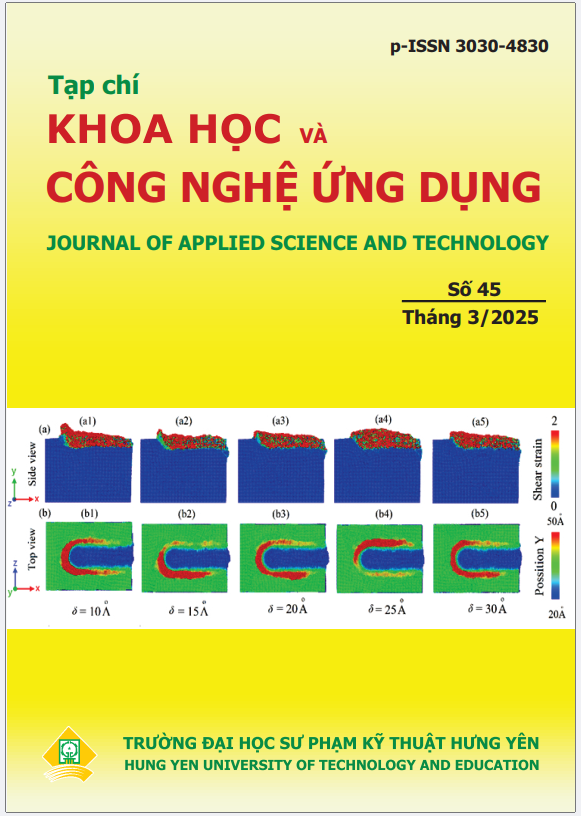SYNTHESIS OF ACTIVATED CARBON FROM LONGAN PEEL AND SEED USING ZNCL₂ AS AN ACTIVATING AGENT
Abstract
In this study, activated carbon (AC) was successfully synthesized from longan peel and seed – an abundant agricultural byproduct – using chemical activation with ZnCl₂. The influence of activating agent concentration, activation temperature, and heating time on the adsorption capacity was investigated, revealing that these parameters significantly affect the quality of the final product. The optimal conditions were determined to be 50% ZnCl₂ concentration, activation temperature of 500 °C, and heating time of 90 minutes. The resulting activated carbon exhibited low moisture content (~4.36%), ash content below 6%, nearly neutral pH (~6.7), an iodine number of approximately 714 mg/g, a methylene blue adsorption capacity of ~236 mg/g, and a surface area of 896.52 m²/g. SEM, XRD, and N₂ adsorption–desorption isotherm analyses indicated a well-developed mesoporous structure and characteristic amorphous nature of the material. These results demonstrate that activated carbon derived from longan peel and seed holds great potential for wastewater treatment applications and highlights an effective approach to valorize agricultural waste into environmentally friendly adsorbent materials.
References
P. González-García, “Activated carbon from lignocellulosics precursors: A review of the synthesis methods, characterization techniques and applications,” Renew. Sustain. Energy Rev., 2018, vol. 82, no. August 2017, pp. 1393–1414, doi: 10.1016/j.rser.2017.04.117.
D. Chen, X. Chen, J. Sun, Z. Zheng, and K. Fu, “Agricultural bio-waste materials as potential sustainable precursors used for activated carbon production: A review,” Bioresour. Technol., 2016, vol. 216, no. 3, pp. 629–636, doi: 10.1016/j.biortech.2016.05.107.
J. M. Dias, M. C. M. Alvim-Ferraz, M. F. Almeida, J. Rivera-Utrilla, and M. Sánchez-Polo, “Waste materials for activated carbon preparation and its use in aqueous-phase treatment: a review,” J. Environ. Manage., 2007, vol. 85, no. 4, pp. 833–846, [Online]. Available: http://www.sciencedirect.com/science/article/pii/S0301479707002964.
S. Uçar, M. Erdem, T. Tay, and S. Karagöz, “Preparation and characterization of activated carbon produced from pomegranate seeds by ZnCl2 activation,” Appl. Surf. Sci., 2009, vol. 255, no. 21, pp. 8890–8896, doi: https://doi.org/10.1016/j.apsusc.2009.06.080.
A. Allwar, M. Noor, and M. A. M. Nawi, “Textural characteristics of activated carbons prepared from oil palm shells activated with ZnCl2 and pyrolysis under nitrogen and carbon dioxide,” J. Phys. Sci., 2008, vol. 19, no. 2, pp. 93–104.
I. Neme, G. Gonfa, and C. Masi, “Activated carbon from biomass precursors using phosphoric acid: A review,” Heliyon, 2022, vol. 8, no. 12, p. e11940, doi: 10.1016/j.heliyon.2022.e11940.
A. P. Khedulkar, B. Pandit, V. D. Dang, and R. an Doong, “Agricultural waste to real worth biochar as a sustainable material for supercapacitor,” Sci. Total Environ., 2023, vol. 869, no. September 2022, p. 161441, doi: 10.1016/j.scitotenv.2023.161441.
V. S. Bhat et al., “Low cost, catalyst free, high performance supercapacitors based on porous nano carbon derived from agriculture waste,” J. Energy Storage, 2020, vol. 32, no. April, p. 101829, doi: 10.1016/j.est.2020.101829.
S. Wannavijit et al., “Evaluation of longan (Dimocarpus longan) peel powder as fruit by-product additive in Nile tilapia (Oreochromis niloticus) feed: Effects on growth, immunity, and immune-antioxidant gene expressions,” Heliyon, 2025, vol. 11, no. 1, p. e41609, doi: 10.1016/j.heliyon.2024.e41609.
J. Yan et al., “Nitrogen-doped oxygen-rich activated carbon derived from longan shell for supercapacitors,” Int. J. Electrochem. Sci., 2020, vol. 15, no. 3, pp. 1982–1995, doi: 10.20964/2020.03.18.
M. Khan et al., “From longan peel waste to energy storage: Porous activated carbon as a cathode matrix for advanced Li/Na-selenium batteries,” Prog. Nat. Sci. Mater. Int., 2024, vol. 34, no. 2, pp. 329–337, doi: 10.1016/j.pnsc.2024.03.004.
J. Yang et al., “Activated Carbon Derived from the Agricultural Waste Camellia Seed Shell for High-Performance Supercapacitors,” ACS Appl. Energy Mater., 2024, vol. 7, no. 2, pp. 469–478, doi: 10.1021/acsaem.3c02391.

